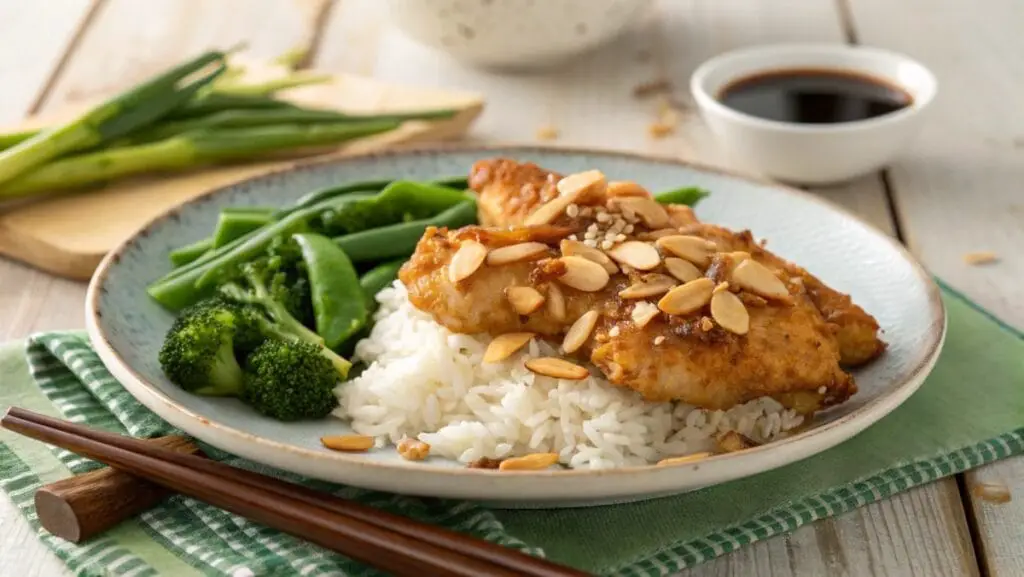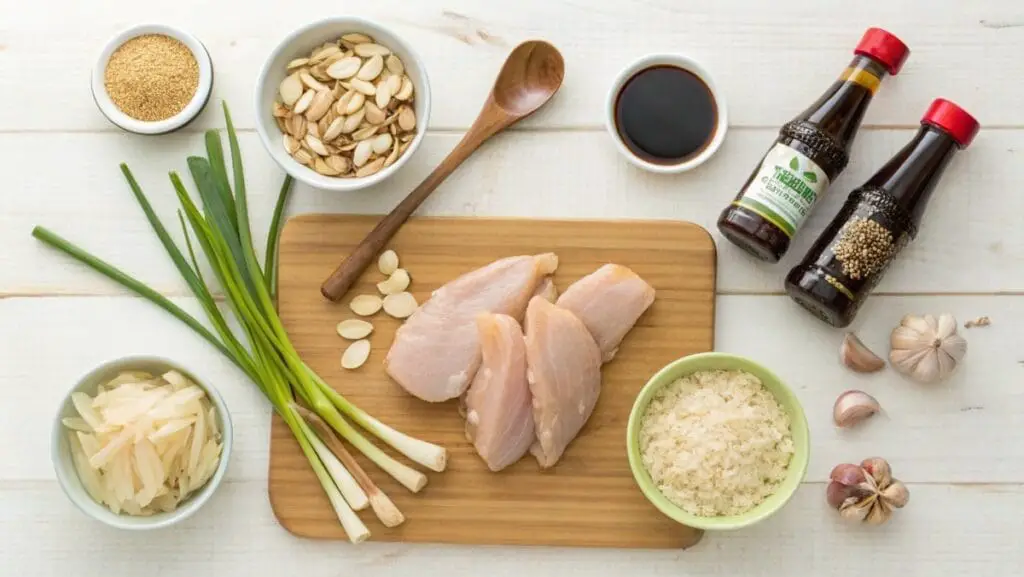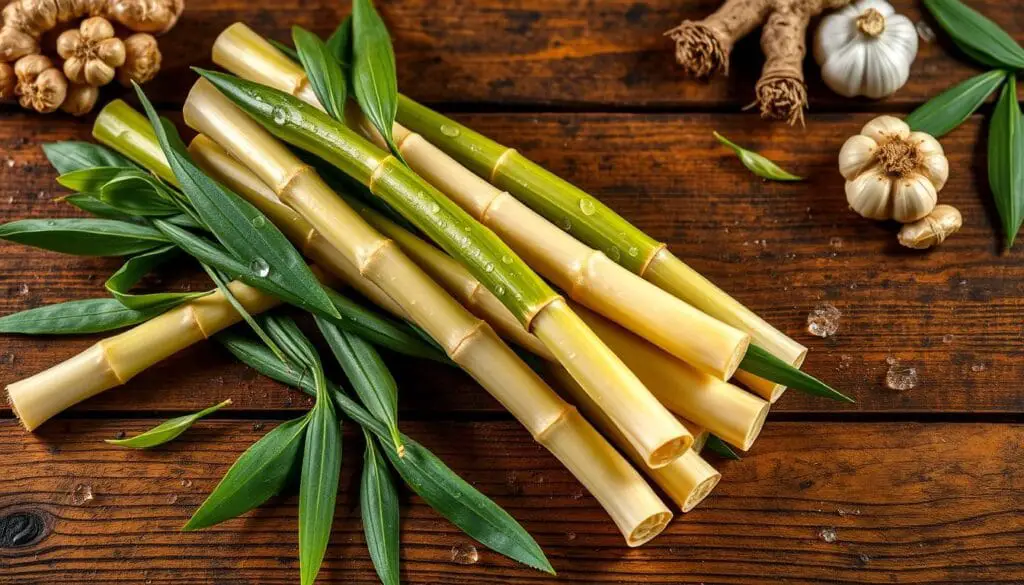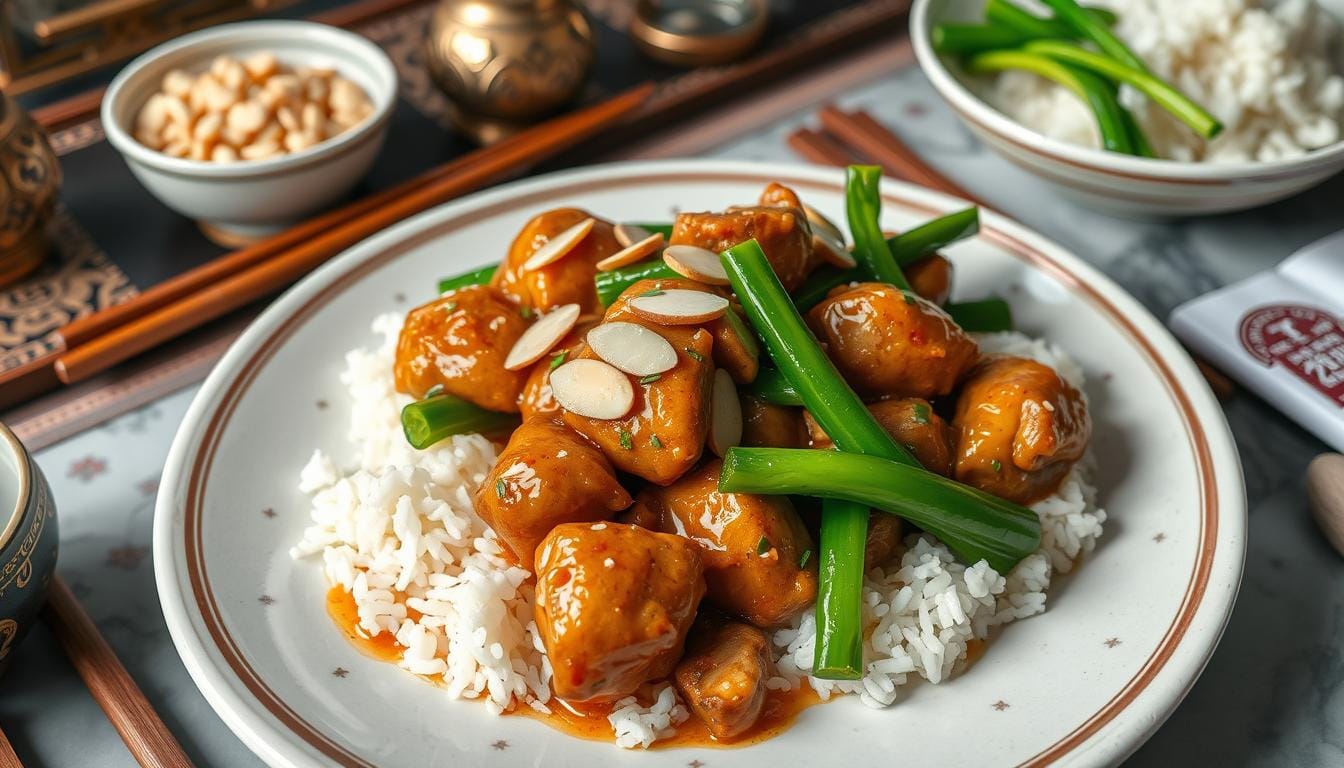Imagine the sizzling aroma of crispy chicken paired with the nutty crunch of almonds. Welcome to the world of Chinese almond chicken, a classic Cantonese dish that combines authentic Asian flavors with a touch of modern creativity. Discover its history, recipe secrets, and how to recreate it at home! It was a sign of special family meals. Chinese almond chicken, rooted in Cantonese cooking, is a favorite. It brings together East and West, offering a taste of China’s rich food culture.
Table of Contents
The Heritage of Cantonese Almond Chicken

Cantonese almond chicken originates from the Lingnan region, known for its rich culinary traditions. Rooted in ancient Chinese cuisine, this dish reflects a blend of bold flavors, including soy sauce, rice wine, and sesame oil, harmonized with the crunch of almonds. This area includes Guangdong and Guangxi provinces. It’s known for its unique cooking and the Cantonese language.
The dish’s roots go back to the Tang Empire’s rule in the 6th and 7th centuries. It was influenced by the ancient Baiyue people and their local ingredients.
Origins in Traditional Chinese Cuisine
Cantonese almond chicken reflects the Lingnan region’s cooking traditions. It uses soy sauce, rice wine, and sesame oil. Seasonal veggies like bamboo shoots add to its flavor.
Evolution in American-Chinese Restaurants
Cantonese cuisine became popular worldwide, and so did Cantonese almond chicken. American-Chinese restaurants made it sweeter to please more people. This mix of flavors made it a favorite Chinese cuisine dish.
Cultural Significance
Cantonese almond chicken is more than food; it’s a symbol of asian flavors and almond dishes loved globally. Its popularity in both Cantonese and American-Chinese restaurants shows food’s power to unite cultures.
“Cantonese almond chicken is a delicious embodiment of the Lingnan region’s rich culinary legacy, showcasing the versatility and adaptability of chinese cuisine on a global scale.”
Essential Ingredients for Authentic Chinese Almond Chicken

To master authentic Chinese almond chicken, selecting quality ingredients is crucial. This recipe calls for tender chicken, aromatic soy sauces, fresh bamboo shoots, and golden slivered almonds. These elements create a dish that’s as visually stunning as it is flavorful. This classic dish from Canton combines chicken recipes, Asian ingredients, and exotic tastes. A few key ingredients make this dish special.
The main protein is chicken, marinated for 30 minutes to boost its taste and texture. The batter, made with flour, water, oil, and baking soda, makes the chicken crispy.
- Chinese Five Spice, a mix of cloves, Sichuan peppercorns, and spices, is in the batter.
- Slivered almonds are fried until golden and used as a crunchy topping.
The sauce is what holds the dish together. It’s a mix of chicken stock, bamboo shoots, soy sauce, cornstarch, and green onions. This blend creates a rich, savory sauce that pairs well with the crispy chicken.
Bamboo shoots are a traditional part but optional in modern recipes. Whether to include them depends on personal taste and how authentic you want the dish to be.
With these key ingredients, Chinese almond chicken offers a unique taste experience. It celebrates the rich flavors and textures of Asian cuisine.
The Perfect Balance of Soy Sauces: Dark vs. Light
The secret to perfecting Chinese almond chicken lies in the balance of soy sauces. Dark soy sauce brings a rich, caramelized color, while light soy sauce enhances the savory depth of the dish. Together, they create a symphony of authentic Cantonese flavors. Chinese Almond Chicken needs dark soy sauce for color and light soy sauce for flavor.
Dark Soy Sauce for Color
Dark soy sauce gives your dish a deep brown color. Our Test Kitchen tried 26 soy sauce brands. They found Pearl River Bridge Superior Dark Soy Sauce to be the best for color.
This soy sauce is low in sodium and rich in umami. It adds depth to your garlic sauces.
Light Soy Sauce for Flavor
Light soy sauce adds flavor to your dish. Our team chose Kikkoman Soy Sauce with Dispenser Bottle as the best for everyday use. It has balanced saltiness and sweetness.
This makes it essential for enhancing the taste of Chinese Almond Chicken.
Combining Techniques
To get the perfect balance, start with dark soy sauce for color. Then add light soy sauce for flavor. Adding a teaspoon of vegetable oil can deepen the color further.
Mastering this technique brings out the true Asian flavors in your Chinese Almond Chicken.
| Soy Sauce Brand | Type | Key Attributes | Price (per 10 oz) |
|---|---|---|---|
| Pearl River Bridge Superior Dark Soy Sauce | Dark | Rich color, complex umami | $8.52 |
| Kikkoman Soy Sauce with Dispenser Bottle | Light | Balanced saltiness, subtle sweetness | $4.33 |
| Yamaroku Kiku Bisiho Artisanal Soy Sauce | White | Delicate, refined flavor | $44.99 |
| Lee Kum Kee Premium Soy Sauce | Light | Versatile for stir-fries | $8.52 |
“The perfect balance of dark and light soy sauces is the key to unlocking the true essence of authentic Asian flavors in your Chinese Almond Chicken.”
Choosing the Right Oil: Peanut vs. Sunflower
When cooking healthy dishes with asian flavors, picking the right oil is key. Both peanut and sunflower oil can greatly impact your Chinese cuisine. They each have special qualities that can boost your Chinese almond chicken’s taste and texture.
Peanut oil is great for stir-frying because it can handle high heat up to 450 degrees Fahrenheit. Its mild taste lets other ingredients stand out. Sunflower oil, with a slightly lower heat tolerance of 440 degrees Fahrenheit, adds a delicate, nutty flavor that pairs well with almond chicken.
| Oil Type | Smoke Point | Flavor Profile | Health Benefits |
|---|---|---|---|
| Peanut Oil | 450°F (232°C) | Neutral, allows other flavors to shine | Low in saturated fat, high in monounsaturated fats |
| Sunflower Oil | 440°F (226°C) | Delicate, nutty flavor | Low in saturated fat, high in polyunsaturated fats |
The choice between peanut and sunflower oil depends on your taste. Both are good for Chinese almond chicken. Pick based on your flavor preferences and the dish’s overall taste.
Choosing the right oil is crucial when cooking at high heat. It prevents the oil from burning and ruining your dish’s taste. By picking the best oil, you can make a tasty and healthy Chinese almond chicken. It will highlight the best of Asian flavors and Chinese cuisine.
Professional Chef’s Secret Techniques
Master Chinese almond chicken like a pro with these chef-approved tips. From achieving the perfect fry to creating a luscious almond sauce, these techniques will elevate your cooking to restaurant-quality. They control temperature, timing, and texture to make each dish a masterpiece. This ensures every bite is a delight.
Temperature Control
Keeping the right temperature is key for stir-frying Chinese almond chicken. Chefs watch the heat closely to avoid overcooking the chicken or burning the sauce. They use hot woks or skillets to sear the chicken, keeping it juicy and crispy.
Timing and Sequence
Adding ingredients at the right time is crucial. Chefs know when to add chicken, aromatics, and sauces for the best flavors. This careful timing makes sure each part is cooked just right, blending flavors and textures beautifully.
Texture Management
Getting the right texture is what makes Chinese almond chicken stand out. Chefs use breading and frying to make the outside crispy and the inside tender. This careful texture management makes every bite satisfying.
These secret techniques help chefs make Chinese almond chicken truly exceptional. By controlling temperature, timing, and texture, they create dishes that amaze and delight. These dishes take diners on a flavorful journey through Chinese cuisine.
| Ingredient | Purpose |
|---|---|
| Roasted, unsalted cashews | Used as an ingredient in the recipe for Chinese almond chicken |
| Water | Required for adjusting the consistency of the sauce in the dish |
| Cornstarch | Functions as a thickening agent in the sauce to provide glossiness and adherence to the chicken |
| Hoisin sauce | Adds sweet, savory, and tangy flavors to the dish, emphasizing the importance of a high-quality brand like Kikkoman or Lee Kum Kee |
| Soy sauce | Contributes saltiness and umami taste to the recipe |
| Boneless, skinless chicken breasts or tenderloins | The recommended cut of chicken for this dish, emphasizing tenderness and suitability for stir-frying |
| Vegetable oil | Utilized for cooking the chicken and aromatics through stir-frying |
| Garlic and scallions | Garlic provides aromatic flavor, while scallions add both flavor and color to the dish |
| Rice vinegar | Adds a tangy and sweet touch to balance out the various flavors in the dish |
| Asian sesame oil | Imparts a distinctive nutty aroma and flavor to the final dish |
By using these secret techniques, chefs make Chinese almond chicken that looks great and tastes amazing. Whether you’re a pro in the kitchen or just starting, these tips can help you make dishes that rival those in restaurants.
Preparing the Signature Almond Sauce
The almond sauce is the heart of Chinese almond chicken. It mixes the nutty taste of almonds with Asian flavors. This creates a perfect balance that makes the dish special. To make the sauce, you need to know a few tricks.
Begin by toasting whole, unblanched almond slivers until they’re golden and crunchy. Almonds are loved in Asian cooking for their meaning of wealth and long life. When chopped right, they add a great texture to the sauce.
Then, make the sauce base by blending soy marinade, garlic chili paste, rice vinegar, sesame dressing, ginger, five-spice powder, and toasted sesame seeds. This mix of flavors gives a bold yet balanced taste that goes well with the chicken. You can adjust the taste by adding sugar for sweetness or more chili paste for heat.
The almond sauce is great for many dishes. It’s perfect as a topping for stir-fries, rice bowls, noodle dishes, or as a marinade or dipping sauce for grilled meats. Its flexibility makes it a key ingredient for anyone who loves almond dishes, garlic sauces, and asian flavors.
“The key to an exceptional almond sauce is finding the perfect balance of flavors and textures. The crunchy almonds, the savory soy, the spicy chili – it all comes together in a harmonious symphony that elevates the entire dish.”
When picking almonds, choose whole, unblanched slivers that are plump and firm. Keep them in an airtight container in a cool, dry place to keep them fresh and crunchy. With a bit of practice, you’ll soon be making delicious almond dishes like a pro.
The Art of Breading and Frying Chinese Almond Chicken

Crispy, golden-brown Chinese almond chicken is a key part of Cantonese cuisine. Learning how to bread and fry it right is essential. This will help you get the perfect texture and taste at home.
Coating Techniques
The breading on Chinese almond chicken does two main things: it keeps the chicken juicy and adds a nice crunch. You can use a mix of ingredients for the breading. Rice flour is good because it uses 50% less oil than wheat flour, making the crust lighter and crisper. All-purpose flour is also great because it can hold buttermilk and seasonings well.
To make it even crisper, add some cornstarch to your breading. Cornstarch absorbs moisture, helping to create a crunchy outside. Try different ratios of flour, cornstarch, and spices to find your favorite breading mix.
Frying Methods
The secret to perfectly fried Chinese almond chicken is in the frying temperature and time. Keep the oil at 350°F (175°C) for even cooking and a golden color. Fry the chicken in batches to avoid overcrowding, which can make the chicken soggy.
For a healthier option, try air frying the chicken. It cooks in 10-12 minutes and is crispy without all the oil. Serve it with homemade almond sauce for a tasty twist.
By perfecting breading and frying, you can make your Chinese almond chicken amazing. It will look great and taste even better. Try different breading and frying methods to find what you like best.
Optional Ingredients and Variations
The classic Chinese almond chicken recipe is a favorite in Cantonese cuisine. It’s a dish that invites you to add your own twist. By exploring almond dishes, asian ingredients, and exotic tastes, you can create unique and delicious versions.
One tasty variation is almond chicken and bacon. It combines the nutty flavor of almonds with the smoky taste of bacon. Adding diced pineapple or mandarin orange segments brings a sweet touch. Mushrooms, like shiitake or oyster, add an earthy flavor. Water chestnuts or bamboo shoots add a nice crunch.
For a bold twist, try adding lemongrass, ginger, or Thai red curry paste. These ingredients can take your almond chicken to new heights. Garnishes like toasted sesame seeds, scallions, or julienned carrots can also make the dish look and feel better.
Whether you choose to add bacon, pineapple, or bold spices, the core of the dish remains the same. Tender chicken, breaded and in a rich almond sauce, is what makes Chinese almond chicken special. Feel free to get creative and find your own favorite way to enjoy this classic dish.
| Ingredient | Quantity | Purpose |
|---|---|---|
| Bacon | 4 slices | Adds savory, smoky notes |
| Pineapple | 1 cup, diced | Provides a touch of sweetness |
| Shiitake mushrooms | 8 oz, sliced | Lends an earthy undertone |
| Water chestnuts | 8 oz, diced | Adds a pleasant crunch |
| Lemongrass | 2 stalks, finely chopped | Infuses a bright, citrusy flavor |
| Ginger | 2 inches, grated | Provides a warm, spicy kick |
| Thai red curry paste | 1 tbsp | Adds a bold, complex flavor |
“Exploring the world of almond dishes opens up a realm of culinary possibilities for Chinese almond chicken.”
Bamboo Shoots: Traditional vs. Modern Adaptations
Bamboo shoots are a key ingredient in Chinese almond chicken. They bring a real touch to this Cantonese favorite. You can find them in asian ingredients stores or big supermarkets. But, the dish still tastes great without them.
Getting bamboo shoots right is key for the best taste and texture in your chinese cuisine.
Sourcing Quality Bamboo Shoots
Fresh bamboo shoots are a seasonal exotic tastes treat. They’re best in the spring and early summer. Look for shoots that are firm, unblemished, and bright green.
Avoid shoots that look dried out or have brown spots. If fresh ones are hard to find, canned or jarred ones can be a good substitute.
Preparation Methods
- Trim the tough outer leaves and cut the shoots into bite-sized pieces.
- Blanch the bamboo shoots in boiling water for 3-5 minutes to remove any bitterness.
- Drain and rinse the shoots under cold water to stop the cooking process.
- For added flavor, sauté the blanched bamboo shoots in a bit of oil with garlic, ginger, or other aromatics before incorporating them into your Chinese almond chicken recipe.

“Bamboo shoots add a delightful crunch and subtle, earthy flavor to traditional Cantonese dishes. While they’re not essential, they do elevate the experience and authenticity of Chinese almond chicken.”
Whether you choose traditional bamboo shoots or modern alternatives, this ingredient can make your chinese cuisine dishes richer and more complex.
Serving Suggestions and Accompaniments
Complete your meal with perfect pairings for Chinese almond chicken. Serve it over steamed jasmine rice, alongside stir-fried vegetables, or with a crisp cucumber salad. These accompaniments highlight the dish’s savory almond sauce and crispy texture. Chinese almond chicken, a beloved Cantonese comfort food, is no different. It pairs well with various sides and accompaniments, making for a complete meal.
For a true Asian flavors experience, serve the chicken with steamed white rice. The rice’s neutral taste lets the chicken’s flavors stand out. You can also try jasmine or basmati rice for a different twist.
- Steamed white rice
- Jasmine or basmati rice
- Stir-fried vegetables
- Sautéed bok choy or Chinese broccoli
- Cucumber salad with rice vinegar dressing
To make the meal healthier, add stir-fried or sautéed veggies. Bok choy, Chinese broccoli, or a mix of carrots, bell peppers, and snow peas are great choices. They add crunch and color to the dish.
For a cool contrast, try a cucumber salad with rice vinegar dressing. It’s a refreshing side that balances the fried chicken’s richness.
Choose sides that make your plate look good and taste great. The right sides will highlight the Chinese cuisine and its Asian flavors. Your Chinese almond chicken will be the main attraction, leaving everyone happy.
Storage and Reheating Tips
Keeping your homemade Chinese almond chicken fresh is easy. Just use the right storage and reheating methods. This way, you can enjoy its crispy texture and sweet flavors for days.
Proper Storage Methods
Store leftover Chinese almond chicken in airtight containers in the fridge. This keeps the flavor in and the chicken moist. Try to eat it within 3-4 days for the best taste.
If you have more chicken than you can eat right away, freeze it. Put the chicken in a freezer-safe bag or container. This way, it can stay good for up to 6 months in the freezer.
Reheating Techniques
- Stovetop Sauté: Heat a lightly oiled skillet over medium-high heat. Add the chicken and sauté for 2-3 minutes, or until heated through.
- Air Fryer: Reheat the chicken in an air fryer at 375°F for 3-5 minutes, tossing halfway, until crispy and hot.
- Oven Baking: Arrange the chicken on a baking sheet and bake at 400°F for 12-15 minutes, flipping once, until piping hot.
- Microwave: Place the chicken in a microwave-safe dish and heat in 30-second intervals, stirring between each, until warmed through.
When reheating, add a bit of broth, soy sauce, or sesame oil. This brings back the dish’s flavors. Enjoy your tasty Chinese almond chicken leftovers!
FAQs
What is Chinese almond chicken?
This iconic Cantonese dish features golden, crispy breaded chicken topped with a savory almond sauce. Paired with crunchy slivered almonds, it embodies the harmony of texture and flavor in authentic Cantonese cooking. It uses two soy sauces for color and flavor.
What are the key ingredients for Chinese almond chicken?
The main ingredients are chicken, almonds, bamboo shoots, and two soy sauces. Dark and light soy sauce are used.
What is the significance of Chinese almond chicken?
It has a rich history in Cantonese cuisine. It’s also popular in American-Chinese restaurants. It shows the mix of Cantonese cooking and American tastes.
How do the two types of soy sauce contribute to the dish?
Dark soy sauce adds color, while light soy sauce adds flavor. Together, they create a perfect balance.
What are the options for the type of oil used in Chinese almond chicken?
You can use peanut or sunflower oil. Both oils give the dish a unique flavor.
Conclusion
Chinese almond chicken is more than a dish—it’s a celebration of Cantonese culinary artistry. Whether you’re savoring its crispy chicken or its rich almond sauce, this recipe brings a piece of Chinese heritage to your table. Ready to try it? Let this classic recipe inspire your next culinary adventure! It’s loved for its crispy texture and savory flavors. This dish has won the hearts of many in the United States.
It started in traditional Chinese cooking and grew in American-Chinese restaurants. Now, it’s a symbol of East meets West, offering a unique taste experience.
Whether you’re a pro chef or a home cook, making authentic Chinese almond chicken is a fun challenge. You’ll learn about key ingredients and techniques. This way, you can make the dish at home, bringing Cantonese flavors to your table.
Chinese almond chicken can be tailored to your taste, making it perfect for everyone. It’s a dish that suits many different tastes and diets.
Exploring Chinese cuisine, Chinese almond chicken is a great starting point. It opens the door to a world of flavors and traditions. Enjoy this dish and let it spark your love for Chinese culinary art.




